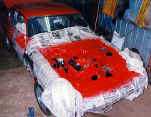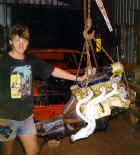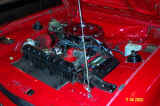|



The real
Capri - not the plastic pop-out of recent years
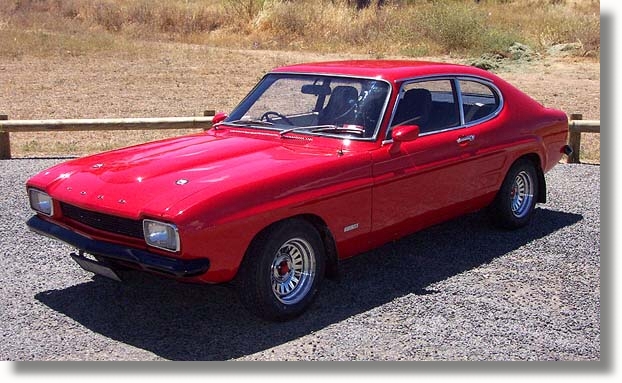
A
long-term member of our family is the Ford V6 Capri.
Our
Capri was built in 1970 and has had only two owners in all this time. The
first owner drove it around Perth, Western Australia, until the beginning of
1974 when Danny traded in his first car - a Burgundy and Doeskin coloured
1962 Wolseley 24/80 - on the Capri. Danny was then 20 and wanted something
reliable and sporty but only had a small budget to work with. The Capri, at
around $2400, fitted the bill. In 1974,
the V6 version of the Capri was also available in limited numbers but the
price was a little outside Danny's range. The idea was to move into something more
modern and trade up every couple of years or so. Twenty eight years later -
the 32 year old Capri is still with us.
|

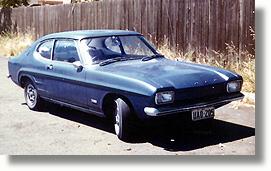
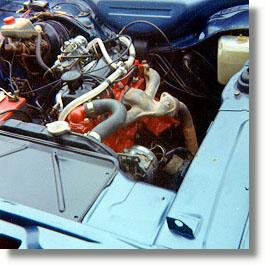
|
Perth
1974
Our
Capri started its life fitted with a four cylinder 1600 cc cross-flow engine
and Borg Warner 35 three speed automatic transmission. The body shape was well ahead of its time
and with its sporty look, metallic blue paint job and brilliant white interior, it really turned
heads. Indeed, the body shape withstood the test of time and still looked
modern for years and years.
Danny
continued to drive the Capri around Perth - as far north as Yanchep and as
far south as Busselton - until he moved to East Sale in Victoria, in mid-1975. On
relocation, the Capri was driven from the west coast to east coast of
Australia, a distance of around 3,000 km. This journey included the
famous Eyre Highway across the Nullabor, which in those days encompassed a
430 km stretch of very rough dirt road ..... er, actually, it was mud.
When Danny moved to Perth in 1973 the Nullabor was a rough dirt road - lots
of corrugations, potholes, heat and bulldust - nearly shook the Wolseley
apart. But when travelling east in the Capri, the rains had arrived and almost the entire unsealed
section was slippery red mud. Not wanting to tackle the mud by night, Danny
slept in the car overnight at Eucla and then headed out across the mud early
next morning. With a 7 x 5 ft trailer in tow and everything he owned on
board .... the combination fish-tailed all over the place, but
surprisingly, the Capri did not get bogged once and managed to get across
under its own steam. Many less fortunate cars and trucks were seen bogged up
to their axles along the way though.
4
Cylinder 1600 cc Cross-Flow Engine |
By early
1975, the Capri's paint job was starting to look a little tired. Metallic
paints do not fare well under the Ultra Violet bombardment of the Australian
sun and the roof and other sections of the paint started crazing. A paint
job was in order. So during Easter of that year Danny took the car to his
brother's house in Melbourne (a panel beater) and repainted it - the same
metallic blue. The engine was removed to paint the compartment, the engine
had a few gaskets changed and the engine given a Rocket Red paint job.
During the period 1975-76, when the Capri was based in Sale, Victoria, it
roamed around Gippsland, from Bairnsdale in the northeast to Melbourne in
the south. In mid-1976, Danny moved to South Australia. There, it spent most
of its time on the roads of Adelaide but made the occasional trip to
Melbourne, Canberra and Port Macquarie on the New South Wales central
coast.
The next
milestone in the Capri's life came in 1978 when the head gasket developed a
water leak, the engine hydraulic locked and damaged a piston and some
bearings. A reconditioned replacement engine was installed but it was a low
quality job (from an allegedly reputable firm) that had a very short service
life and required a rebuild by 1981. That was done, again at Danny's
brother's house in Melbourne, along with a recondition of the BW 35
transmission - piece of cake really.

San
Remo Green with Tan Vinyl Roof and Rocket Wire Rims
During
the engine and gearbox rebuild, Danny also took the opportunity to give the
Capri a real face-lift by painting it a light metallic green (Honda's San
Remo Green) and having a tan vinyl roof applied. The bumpers were buffed up
and given a satin black paint job. A black spoiler was fixed to the boot
lid. The latter looked good at the time but the screw holes caused the boot
lid to rust and had to be replaced a few years later - lesson - don't drill
holes in boot lids. The standard Capri tail lights (very small
and ineffective) were removed, a bit of panel surgery performed, and Holden
Torana Sunbird tail lights were installed. They look like they were made for
the Capri. Best favour Holden ever did Ford. Inside, a Pioneer cassette stereo
system was installed and the standard black carpet was replaced with a rich
tan. The white vinyl trim remained in reasonably good condition.
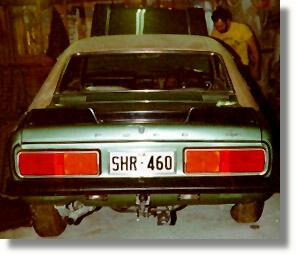 Sunbird
Tail Lights Sunbird
Tail Lights
While
the car was being refurbished a neighbour popped in to admire the work
underway. He remarked in passing that he had a brother on a farm who used to
have a V6 Capri and that he had a broken V6 engine and assorted parts still lying in
his shed - was Danny interested? Well, yes .... and the project to turn the
Capri into a V6 began.
It took
some years to accumulate all the parts necessary to convert the Capri into
an almost genuine V6. The engine was purchased from the farm for $200
(Danny's brother beat him down from $250) and came fully complete with
clutch (such as it was), gearbox and drive shaft. That combination was
selling elsewhere at the time for $1,000 (albeit in working order). We
discovered that the engine had broken a piston rod in its previous life but
clearly continued to run on five cylinders. The owner had driven the car,
riding the clutch until it had finally burnt out and welded itself to the
flywheel, at which time he pulled that engine out and put another in. We
bought the engine in the same condition as it was pulled out - one of the
pistons and its con rod was totally missing - a mass of very small metal
fragments in the sump was all that remained. Normally this much damage and abuse would spell the end of
an engine
but as luck would have it, damage to the bore was minor and above the
stroke, the crankshaft was trashed and needed replacing and the other
bearings were somewhat worse for wear having enjoyed running on metal filings
during its clutch riding days. In the big scheme of things though, it was
all easy to repair or replace and the engine purchase was still a
bargain.
 Ignore
the cutie - its the white trim on show here
Ignore
the cutie - its the white trim on show here
The hunt
for V6 parts was assisted by an acquaintance of Danny's who also had a V6
Capri but had whipped that out and replaced it with a Windsor 302 V8. Danny
purchased many V6 parts from him at bargain prices.
The
restoration process began with a gearbox overhaul - before the Capri, and
lots of boxes of parts, were relocated with the family (yes Danny had
accumulated a family by this time) to Canberra in the Australian Capital
Territory - November 1984.
By the
time the Capri hit the streets of Canberra the trim was really starting to
show its age and Danny was also a bit nervous about driving around in low
back bucket seats - whiplash waiting to happen. So he prowled the wreckers
looking for high back bucket seats - which he found - from a late model
Escort. But while searching for the seats he chanced upon a Capri rolling
shell at the wreckers, complete with V6 bonnet but minus the engine and
gearbox - a plan was hatched. The V6 would go into a totally different body
- and the paint job of choice was to be a Black and Gold John Players
Special - as per the racing teams of the day.
 To cut a
long story short, the V6 engine was rebuilt in Canberra during 1985 and
installed in the rolling shell before further restoration was interrupted by
another employment related move - this time to Townsville, North
Queensland. But before this happened, Danny discovered that the cold
winter weather in Canberra (aided by a persistent electrical system fault)
was hell on batteries. The car kept getting caught with a flat battery and
with an automatic transmission precluding push starting, Danny decided to
convert the car to a manual gearbox. A Cortina MK 1 gearbox, compatible bell
housing and clutch assembly was sourced; and a single piece drive shaft was
fabricated at a local engineering shop. The conversion was trouble free. To cut a
long story short, the V6 engine was rebuilt in Canberra during 1985 and
installed in the rolling shell before further restoration was interrupted by
another employment related move - this time to Townsville, North
Queensland. But before this happened, Danny discovered that the cold
winter weather in Canberra (aided by a persistent electrical system fault)
was hell on batteries. The car kept getting caught with a flat battery and
with an automatic transmission precluding push starting, Danny decided to
convert the car to a manual gearbox. A Cortina MK 1 gearbox, compatible bell
housing and clutch assembly was sourced; and a single piece drive shaft was
fabricated at a local engineering shop. The conversion was trouble free.
From
1985 to 1991, little work was done on the V6 project. During this time, the
Capri was based successively in Townsville, Brisbane and then back to
Canberra where it largely just commuted around town, although the rare long
distance trip did occur. During this
time, the rolling shell was also relocated to Telegraph Point, NSW, where Danny's
brother, Peter, had moved onto a farm. It quickly became apparent though, that the rolling
shell had far too much rust and too many dents to make it practical to
restore (especially with a high gloss black JPS paint job) so the engine was
removed, the body stripped of useful parts and disposed of.
By 1992, the green paint job and vinyl roof were declared well and truly past
their use-by-date. A few years under the tropical sun had taken its toll. So
Danny drove the car to Telegraph Point and spent two weeks of very long days
overhauling the cosmetics. Because of the very poor state
the paint was in (not to mention having to deep-six the vinyl roof and
restore the metal surface), the vehicle was totally stripped down to a metal
shell. Paint stripper was used to help "deglaze" the many layers
of paint accumulated over the years. This had the unfortunate side effect of
chewing out any body filler that had been applied to small dents and surface
irregularities over the years. This meant the entire body had to be refilled
and resmoothed where necessary. Underneath the car was cleaned up and a rust
proofing / sound deadening coat of bitumen paint was reapplied. Danny was very
ably assisted by his brother Peter, specialising in panel beating and spray
painting. The paint chosen was a two-pack 1992 Celica Red. It was a last minute
choice, having only just spotted a red Celica on the way to purchasing
paint. It saved lots of time in otherwise having to troll through colour
charts and try to imagine what the colour would look like when applied to
the car. As it turned out though, the chosen red was much brighter and more
orangey than intended, so the car isn't quite the red originally anticipated
- but it's done now.
|
|

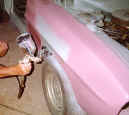

|
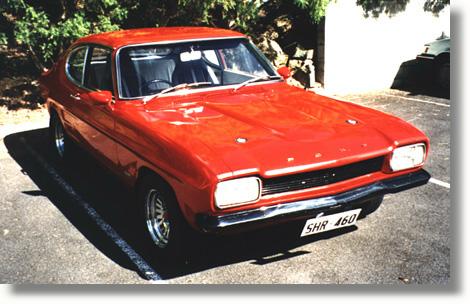
(click on
thumbnails for larger pics)
|

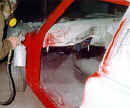

|
|
By
now, all the V6 drive train components had been sourced and were ready to go so Danny
took the car to Port Macquarie for the engine conversion. Enroute, the four cylinder started spitting oil and
billowing smoke and only just made it up the steep hill to the farm,
virtually on the edge of extinction. It would not have made another 50 km. A
cop pulled Danny over along the way because of the smoke trail he was
leaving but decided not to ticket him when he discovered that the engine
problem had indeed only just happened that morning - as evidenced by an
otherwise clean and tidy engine compartment and underbelly sprayed with
fresh oil.
After
about a week, the V6 was in and ready to go for the first time.
After about two minutes of cranking to get fuel and oil flowing, it
burst into life. But after burning off the cobwebs and then running
relatively smoothly for about 40 seconds, it suddenly came to a
grinding halt. There was then much cursing, wringing of hands and
banging of heads, before we finally decided the engine had seized
and needed to come out and be stripped down to find the cause. And
the cause took some finding. After lots of searching, the culprit
turned out to be the small gasket that goes between the base of the
oil pump pick-up pipe and the engine block - the gasket had no
hole - it hadn't been punched through. It is still a mystery how the
engine got assembled without the faulty gasket not being noticed,
but that's history now. The only apparent damage was a few
crankshaft bearings - but the lot were replaced (after waiting a day
or two for them to be delivered from Sydney). The engine was cleaned
up, reassembled and put back in the car. But disaster struck again
on the restart - the engine ran for about 20 minutes but then
started issuing a huge repetitive squeak. Another heart-in-the-mouth mystery.
To
cut a long story short, the engine cleanup after the previous seizure was
less than perfect and corners were cut. Instead of totally tearing
down the engine to be sure all the metal swarf had been removed,
just solvent and air pressure was used. Clearly that wasn't good
enough and enough fine metal debris had remained to chew out one of the
conrod bearings during the second starting attempt. The squeak was
caused when that particular piston came under load on its firing
stroke - remove the spark plug and no squeak. Sounds simple but that
took a long time to diagnose.
Another
engine removal, more bearings and another strip clean of the engine
- this time a complete teardown. By now, Danny had run out of
holiday leave and had to return to Canberra. Leaving the engine in
bits on the bench and a new set of bearings ordered, Danny's nephew,
Glenn, kindly completed the rebuild. He obviously has the golden touch as
he got the car up and running, tuned it and after some test driving,
delivered it personally to Canberra a couple of weeks later. What a
deal ! And what a car ! The power difference between the old four
cylinder and the 3 Litre V6 is amazing - even though the engine is
very low-tech and the gear ratios made for quick takeoffs, rather than
quiet high speed cruising.
After
the V6 conversion dramas, the car (and its owners) settled down
quite quickly and attention then turned to the interior of the
vehicle. However, after only the dash had been reconditioned (vacuformed)
and the
carpet replaced, Danny's employment took he and the family overseas
for two years. After expending so much effort on the vehicle (and
having had the car for 20 years) it was decided to put the car into
storage for two years. So the Capri went for a holiday at the local
U-Stow-It. It was late 1993.
In
January 1996, The Capri again saw the light of day. Requiring only a
new battery, HT leads and spark plugs (a misfire had developed the
day before it went into storage), the car quickly lept into life. It
then journeyed with the family to its new home in Brisbane, where it
spent the next two years commuting about 70 km per day into the
countryside. Most of it was relatively trouble-free. The radiator
core needed replacing after a while (probably damaged by sitting
idle in storage for two years) and a relatively major breakdown occurred when a
couple of teeth on the fibre timing gear sheared, causing some
valves to clash with the pistons. Luckily it happened at low speed
and the subsequent engine noise sounded
worse than it really was. It was eventually rectified quite simply
with some new valves, a little head refurbishment work and a gasket
set. The pistons were undamaged.
In
1998. the Capri moved back to Canberra for its third time prowling
around the streets of the capital. In the intervening period it has
been trouble-free, but of late has developed both a clutch and gear shift
lever problem that will
require minor surgery.
So
here we are in 2002. The Capri is now in its 33rd year and still
going better than Mr Ford probably ever expected. It still needs its
interior refurbished, the engine is getting a little tired again and
could do with an overhaul in the next year or two but it drives well (overlooking the
temporary clutch problem) and the body is still in excellent
condition.
And
its future ? Well believe it or not, it's up for sale - looking for
a good home, so to speak.
We
bought a Nissan Patrol last December and are busy kitting it out for
serious off road driving - that has now become our project car and
consumer of spare time. We also still have the fully kitted out Subaru
4WD wagon - another consumer of time. So it is getting more difficult
to find the time and money (and dare I say, enthusiasm) to maintain
the fleet. It's time to let someone else have a go and finish the
restoration project. . . . .
.
. . . . . and before you ask, kids - no you can't
have it - Danny will only end up getting suckered into maintaining it for
another 20 years or so !
|
|
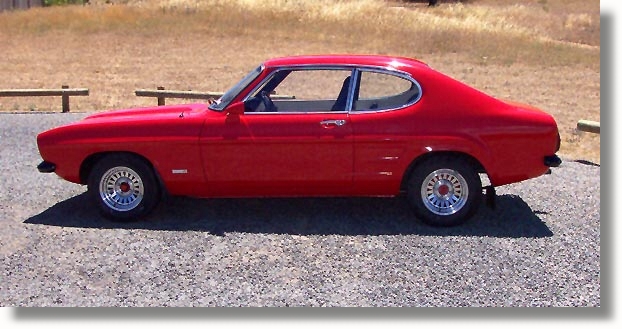
|
| Footnote:
The Capri has
been registered in WA, SA and the ACT
It has been
garaged in Perth, East Sale, Adelaide, Townsville, Brisbane (twice)
and Canberra (three times)
It has
mercifully been spared from any major collisions - the only damage
being:
1974 -
Skidded into a truck that tried to cross a very busy road and then
stopped dead across the lane (FR guard replaced)
1979 - Impact
by another vehicle turning left without indicating (FR guard
repaired)
1981 -
Passenger door damaged by another car reversing into it (door skin
replaced)
1982 - 1600cc
minor engine fire - fuel hose leak dripping on distributor - known
design fault (1600cc bonnet repainted)
|
Back
to the cars  Back to the
cars
Back to the
cars
|








 Sunbird
Tail Lights
Sunbird
Tail Lights Ignore
the cutie - its the white trim on show here
Ignore
the cutie - its the white trim on show here To cut a
long story short, the V6 engine was rebuilt in Canberra during 1985 and
installed in the rolling shell before further restoration was interrupted by
another employment related move - this time to Townsville, North
Queensland. But before this happened, Danny discovered that the cold
winter weather in Canberra (aided by a persistent electrical system fault)
was hell on batteries. The car kept getting caught with a flat battery and
with an automatic transmission precluding push starting, Danny decided to
convert the car to a manual gearbox. A Cortina MK 1 gearbox, compatible bell
housing and clutch assembly was sourced; and a single piece drive shaft was
fabricated at a local engineering shop. The conversion was trouble free.
To cut a
long story short, the V6 engine was rebuilt in Canberra during 1985 and
installed in the rolling shell before further restoration was interrupted by
another employment related move - this time to Townsville, North
Queensland. But before this happened, Danny discovered that the cold
winter weather in Canberra (aided by a persistent electrical system fault)
was hell on batteries. The car kept getting caught with a flat battery and
with an automatic transmission precluding push starting, Danny decided to
convert the car to a manual gearbox. A Cortina MK 1 gearbox, compatible bell
housing and clutch assembly was sourced; and a single piece drive shaft was
fabricated at a local engineering shop. The conversion was trouble free.







